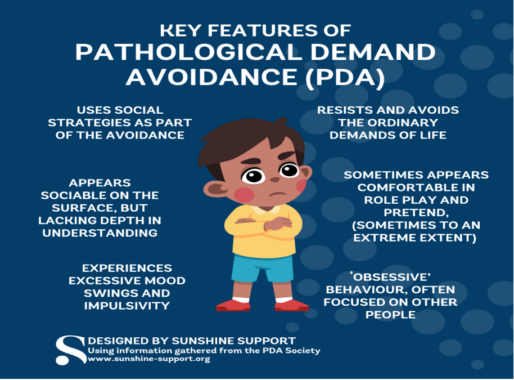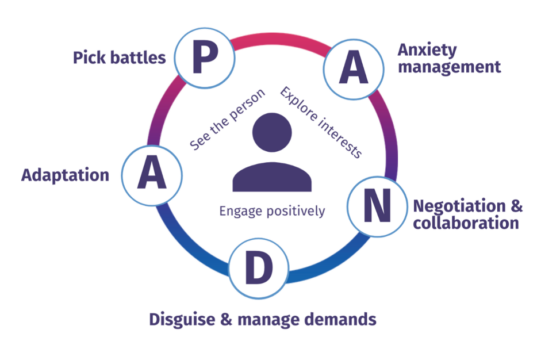Pathological Demand Avoidance (PDA): What is it? And how can we support individuals with a PDA profile?
laura on 06/03/2024

Image source: https://sunshine-support.org/resources/#infographics
What is Pathological Demand Avoidance
Pathological demand avoidance, or Pervasive Drive for Autonomy (PDA)*, is an anxiety-driven need for control and resistance to demands/expectations that threaten a sense of autonomy. Whilst everyone experiences demand avoidance at times (e.g., refusing to complete homework or household chores), for individuals with PDA, everyday demands such as “put on your shoes” or “take a shower” can cause significant anxiety and evoke extreme emotional reactions (panic attacks or meltdowns). In fact, individuals with PDA may resist demands even if it’s something that they enjoy or want to do. It is the expectation, rather than the nature of demands, that leads to a perceived lack of control. Thus, demands that may trigger PDA include:
- Direct Demands: Instructions e.g., Brush your teeth, put your shoes on, do your homework, corrections, or discipline.
- Indirect Demands: Praise, discussions/comments about the future, transitions, social expectations.
- Internal Demands: Hunger, thirst or needing to use the bathroom.
- Wants/desires: Hobbies/interests, special occasions.
*Pervasive drive for autonomy is the preferred name for many within the autistic community.
So, how do we identify individuals with a PDA profile?
Core Features of a PDA Profile
At present, PDA is not included in the International Classification of Diseases (ICD-11) or the Diagnostic Statistical Manual (DSM-5-TR) as a formal diagnosis. Rather, PDA is currently considered a profile of autism characterised by:
- Resistance/avoidance to ordinary demands of life and use of “social strategies” to regain autonomy:
- PDAers may employ various social techniques as a means of avoiding demands, including:
- Distraction: Giving compliments, changing the subject, feigning injury, mimicking.
- Excuse Giving: “My legs don’t work”, “I can’t hear you”, “I’m blind.”
- Refusal: “NO!” “I can’t do that.”
- Withdrawing into fantasy: “I’m a dinosaur.”
- Controlling the actions of others around them: “You do it”, suggesting alternatives.
- These behaviours can often be misinterpreted by others as manipulative. When distraction, control and avoidance strategies fail, anxiety levels are heightened, and distress escalates, which can lead to aggression (hitting, kicking, biting), elopement, or self-harm. It is important to note that these behaviours are not deliberate; rather, PDAers experience panic and a fight/flight/freeze/fawn response.
- PDAers may employ various social techniques as a means of avoiding demands, including:
Image by https://www.thinkpsychologists.com.au/blog/pda-pathological-demand-avoidance/
- Surface social communication abilities:
- PDAers may present with less obvious differences in social communication and understanding than other autistic children. They may have strong verbal fluency and exhibit more eye contact. However, they may also struggle with understanding social hierarchy, e.g., wanting to be co-teachers or co-parents, and have a preference for being in control during play.
Other key characteristics include:
- Intense emotions or mood swings
- Comfort in role-playing and storytelling
- Intense focus on interests, often directed at other people
Pathological demand avoidance can present differently depending on the setting and an individual’s capacity for demands at any one time. In school, a PDA child may refuse to start tasks or engage in distracting behaviours to avoid work. At home, they may have frequent meltdowns about routine tasks such as taking a shower or getting dressed.
So, how can we support individuals with PDA?
Strategies to Support PDA Children
It is important to understand that PDA behaviour is driven by anxiety and that PDAers respond to demands as if they are a direct threat to their safety or well-being. Thus, low arousal approaches that reduce anxiety and provide a sense of control are essential for supporting PDAers. The Pathological Demand Avoidance Society recommends an approach that is flexible, based on trust, and collaborative. This is called the PANDA approach, as outlined below.
Image by PDA Society UK
- Pick Your Battles:
- Minimise non-essential rules and agree on non-negotiable boundaries – Ask yourself what rules are important for the child, family or class. Prioritise rules as high, medium or low priority.
- Allow for some choice/control by providing two options or allowing “no” as a response.
- Provide explanations.
- Manage Anxiety:
- Recognise and respond to the child’s cues that they are becoming overwhelmed or stressed.
- Reduce uncertainty.
- Treat distressed behaviours as panic attacks and support throughout
- Recognise that when in a heightened state, a child is not fully in control of his or her behaviour, as the emotion centre of their brain takes over.
- Negotiate/Collaborate:
- Keep calm
- Proactively negotiate
- Disguise Demands:
- Reframe requests – Instead of using words such as “need”, “must” “wont” “can’t” or “it’s time to” try using phrases such as “is it okay with you” “how do you feel about”, “I wonder.”
- Use declarative language, e.g., “The clothes are on the bed.”
- Disguise demands as challenges – “I bet I can get my coat on first”.
- De-personalise the request, e.g., “it’s the school rules.”
- Adapt:
- Use humour, novelty, distraction, and roleplay.
- Be flexible and have a plan B.
- Be cautious with rewards or praise:
- Rewards charts can create additional demands if the original demands are not achieved. Instead, try providing spontaneous rewards.
- Praise or encouragement can be perceived as a demand; instead, try providing praise indirectly or focusing on the process. When offering encouragement, provide choices or exit strategies.
Resources
If you’d like to learn more about PDA and how it presents, please see the following:
Websites
- Australian Childhood Trauma Group – What is Pathological Demand Avoidance?
- PDA Society (UK) – What is Demand Avoidance?
Books
- Understanding Pathological Demand Avoidance Syndrome in Children: A Guide for Parents, Teachers, and Other Professionals by Phil Christy, Margaret Duncan, Ruth Fiddler, and Zara Healy.
- Me and My PDA: A Guide to Pathological Demand Avoidance for Young People by Gloria Dura-Vila and Tamar Levi.
- The Educator’s Experience of Pathological Demand Avoidance by Laura Kerbey
If you’re noticing patterns of demand avoidance in your child or would like some help supporting individuals with a PDA profile, please feel free to contact our admin team on 9802 4654.
This blog was written by Michaela Hughes – Psychologist at YMM.
Michaela has a special interest in working with children and young people with a range of neurodevelopmental disorders including Autism Spectrum Disorders (ASD), ADHD, Intellectual Disability and Language Impairment.
Michaela believes in a warm, empathetic, and collaborative approach to the therapeutic process and that treatment should be tailored to the client’s individual needs. She strives to adopt a client-centred approach, drawing on a range of evidence-based treatments including cognitive behavioural therapy, play-therapy and mindfulness-based therapy.
To learn more about Michaela, check out the “Our Team” page on our website! https://yourmindmatters.net.au/our-team/
- Category: Child development and parenting, Neurodiversity

